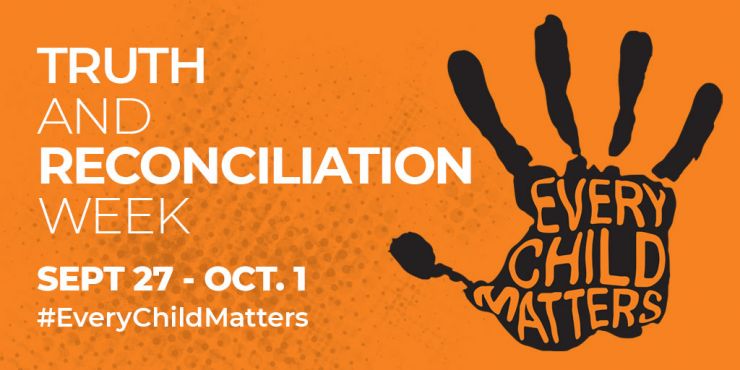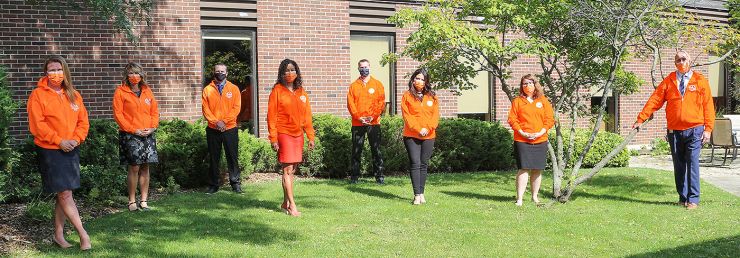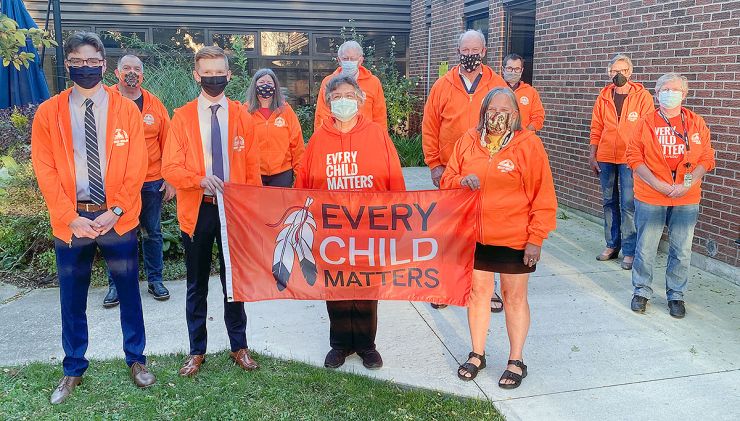
 |
| Above: Members of Grand Erie's senior administration team stand together for Orange Shirt Day. |
Learning is a Focus for Truth and Reconciliation Week in Grand Erie
Grand Erie District School Board is getting ready to mark National Day for Truth and Reconciliation and Orange Shirt Day on September 30 by ensuring schools have what they need to support Indigenous-focused learning for all students during Truth and Reconciliation Week (Sept. 27 - Oct. 1) and throughout the school year.
"Providing opportunities to learn about our collective histories and recognize the intergenerational trauma that has resulted from Canada's residential school system is crucial to the process of reconciliation," said JoAnna Roberto, Director of Education for Grand Erie. "Grand Erie remains committed to respond to Calls to Action 62 and 63 from the Truth and Reconciliation Commission’s report and ensuring that the experiences and contributions of First Nations, Métis and Inuit peoples is embedded in the work we do."
 |
| Above: Grand Erie Trustees unite to show support for Truth and Reconciliation Week. |
In preparation for this week, Grand Erie's Indigenous Education team has curated and packaged kits containing books, lesson plans and other resources to enhance classroom learning. The age-appropriate contents cover topics such as Missing and Murdered Indigenous Women and Girls, Treaty rights, environmental teachings, “Rock Your Mocs” activities, as well as resources to highlight days of significance during the school year. A new cultural kit will be distributed each month to schools across the district.
"The aim of the kits is to facilitate meaningful reconciliation and empower all of us to be a part of this critical process," said Robin Staats, Principal Leader of Indigenous Education and Equity in Grand Erie. "They deal with challenging, complex, and painful events that have shaped the relationships between Indigenous and non-Indigenous peoples in Canada, and by bringing these issues to light in the classroom, we move beyond history and towards the responsibilities we have today and for future generations."
![Cultural-Kit-Orange-Shirt-Day[2].jpg](/application/files/thumbnails/small/1516/3292/9415/Cultural-Kit-Orange-Shirt-Day2.jpg) |
| Above: Curated Grand Erie Cultural Kits containing books, lesson plans and other resources to enhance classroom learning have been sent out this week to Grand Erie schools. |
In classrooms, integrating the histories and achievements of First Nations, Métis and Inuit peoples remains a priority. A mandatory Grade 11 English course focused on Indigenous authors is in its third year. A widely offered Grade 10 course, First Nations, Métis, and Inuit in Canada, conveys the dynamic and diverse histories of Indigenous peoples to inform critical thinking of current issues and events.
Grand Erie students and staff will be wearing orange on September 30, and participating in events such Orange Shirt Day walk-a-thons aimed at raising awareness and fostering discussion.
Soon, the board will begin a public consultation process looking into renaming Ryerson Heights Elementary School in west Brantford, to formally recognize that the legacy of Egerton Ryerson does not align with Grand Erie values.
Grand Erie’s Multi-Year Strategic Plan includes Belonging as one of its collective priorities to support an equitable, inclusive and responsive environment for each learner.
Good Food Adds Up to Good Learning at Courtland Pubic School
Evidence suggests that breakfast and snack programs in schools:
- Improves children’s school performance, memory and test grades
- Enhances students’ physical, emotional, social and intellectual development
- Increases attendance rates, particularly for nutritionally at risk children
- Provides additional time for children to eat and drink nutritious breakfasts and snacks
- Provides energy for students to be more physically
- Enhances nutritional status of students by replacing the consumption of foods with low nutritional value with more nutritious choices, such as more vegetables and fruit
- Promotes a sense of community by bringing people together to ensure all children are well-nourished
- Leads to better dietary habits by increasing the frequency of eating breakfast
- Reduces the prevalence of vitamin and mineral deficiencies
With the generous support of the Child Nutrition Network and the Grand Erie District School Board, the school was able to renovate a room in the school into a nutrition program kitchen. Funds provided by the Child Nutrition Network and school fundraising monies purchase the good food and materials needed to run the program.
Every morning at 8 a.m., parent volunteers and their children arrive to prepare and distribute the food for the day. This program would not happen without their enthusiastic support.
Each serving of food includes a dairy product (i.e. yogurt, cheese string), a grain product (i.e. crackers, mixed cereal, muffin, whole wheat bun) and a fruit product (i.e. apple, banana, clementine orange, grapes, juice) or a vegetable product (i.e. cucumber slices, raw carrots). A container filled with food is delivered to each classroom and as children get settled for a day of learning, staff and students are encouraged to help themselves to a delicious and nutritious start to the day.
“Nutrition programs, such as the one at Courtland Public School, are happening in many schools within the Grand Erie District School Board. It’s a huge effort supported by the Board, volunteers and community agencies. Working together, it’s amazing what can be done. We feel most grateful to have this opportunity for our Courtland school community”, says principal Deb Opersko.
Roots of Empathy
Courtland Public School offers the Roots of Empathy program in our Kindergarten A classroom. Our Early Childhood Educator, Mrs. L. Wildman is a trained Roots of Empathy instructor. Our Roots of Empathy baby and her mom are welcome visitors to the classroom.
An explanation of program, from the Roots of Empathy website is included below:
Roots of Empathy is an evidence-based classroom program that has shown significant effect in reducing levels of aggression among schoolchildren by raising social/emotional competence and increasing empathy. The program reaches elementary schoolchildren from Kindergarten to Grade 8. In Canada, the program is delivered in English and French and reaches rural, urban, and remote communities including Aboriginal communities. Roots of Empathy is also delivered in New Zealand, the United States, Isle of Man, the Republic of Ireland, Northern Ireland and Scotland.
Emotional Literacy
At the heart of the program are a neighbourhood infant and parent who visit the classroom every three weeks over the school year. A trained Roots of Empathy Instructor coaches students to observe the baby's development and to label the baby's feelings. In this experiential learning, the baby is the "Teacher" and a lever, which the instructor uses to help children identify and reflect on their own feelings and the feelings of others. This "emotional literacy" taught in the program lays the foundation for more safe and caring classrooms, where children are the "Changers". They are more competent in understanding their own feelings and the feelings of others (empathy) and are therefore less likely to physically, psychologically and emotionally hurt each other through bullying and other cruelties. In the
Roots of Empathy program children learn how to challenge cruelty and injustice. Messages of social inclusion and activities that are consensus building contribute to a culture of caring that changes the tone of the classroom. The Instructor also visits before and after each family visit to prepare and reinforce teachings using a specialized lesson plan for each visit. Research results from national and international evaluations of Roots of Empathy indicate significant reductions in aggression and increases in pro-social behaviour.



